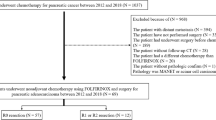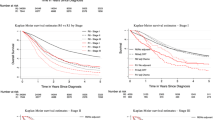Abstract
Objectives
We aimed to systematically evaluate the diagnostic accuracy of CT-determined resectability following neoadjuvant treatment for predicting margin-negative resection (R0 resection) in patients with pancreatic ductal adenocarcinoma (PDAC).
Methods
Original studies with sufficient details to obtain the sensitivity and specificity of CT-determined resectability following neoadjuvant treatment, with a reference on the pathological margin status, were identified in PubMed, EMBASE, and Cochrane databases until February 24, 2020. The identified studies were divided into two groups based on the criteria of R0 resectable tumor (ordinary criterion: resectable PDAC alone; extended criterion: resectable and borderline resectable PDAC). The meta-analytic summary of the sensitivity and specificity for each criterion was estimated separately using a bivariate random-effect model. Summary results of the two criteria were compared using a joint-model bivariate meta-regression.
Results
Of 739 studies initially searched, 6 studies (6 with ordinary criterion and 5 with extended criterion) were included for analysis. The meta-analytic summary of sensitivity and specificity was 45% (95% confidence interval [CI], 19–73%; I2 = 88.3%) and 85% (95% CI, 65–94%; I2 = 60.5%) for the ordinary criterion, and 81% (95% CI, 71–87%; I2 = 0.0%) and 42% (95% CI, 28–57%; I2 = 6.2%) for the extended criterion, respectively. The diagnostic accuracy significantly differed between the two criteria (p = 0.02).
Conclusions
For determining resectability on CT, the ordinary criterion might be highly specific but insensitive for predicting R0 resection, whereas the extended criterion increased sensitivity but would decrease specificity. Further investigations using quantitative parameters may improve the identification of R0 resection.
Key Points
• CT-determined resectability of PDAC after neoadjuvant treatment using the ordinary criterion shows low sensitivity and high specificity in predicting R0 resection.
• With the extended criterion, CT-determined resectability shows higher sensitivity but lower specificity than with the ordinary criterion.
• CT-determined resectability with both criteria achieved suboptimal diagnostic performances, suggesting that care should be taken while selecting surgical candidates and when determining the surgical extent after neoadjuvant treatment in patients with PDAC.



Similar content being viewed by others
Abbreviations
- AHPBA:
-
American Hepato-Pancreato-Biliary Association
- CA:
-
Celiac axis
- CCRT:
-
Concurrent chemoradiotherapy
- CHA:
-
Common hepatic artery
- HSROC:
-
Hierarchical summary receiver operating characteristics
- NCCN:
-
National Comprehensive Cancer Network
- PDAC:
-
Pancreatic ductal adenocarcinoma
- PRISMA:
-
Preferred Reporting Items for Systematic Reviews and Meta-Analyses
- PV:
-
Portal vein
- QUADAS-2:
-
Quality Assessment of Diagnostic Accuracy Studies
- SMA:
-
Superior mesenteric artery
- SMV:
-
Superior mesenteric vein
References
Hidalgo M (2010) Pancreatic cancer. N Engl J Med 362:1605–1617
Ryan DP, Hong TS, Bardeesy N (2014) Pancreatic adenocarcinoma. N Engl J Med 371:2140–2141
Mercadante S, Tirelli W, David F et al (2010) Morphine versus oxycodone in pancreatic cancer pain: a randomized controlled study. Clin J Pain 26:794–797
Tempero MA, Malafa MP, Chiorean EG et al (2019) Pancreatic adenocarcinoma, version 1.2019. J Natl Compr Canc Netw 17:202–210
Versteijne E, Vogel JA, Besselink MG et al (2018) Meta-analysis comparing upfront surgery with neoadjuvant treatment in patients with resectable or borderline resectable pancreatic cancer. Br J Surg 105:946–958
Suker M, Beumer BR, Sadot E et al (2016) FOLFIRINOX for locally advanced pancreatic cancer: a systematic review and patient-level meta-analysis. Lancet Oncol 17:801–810
Somers I, Bipat S (2017) Contrast-enhanced CT in determining resectability in patients with pancreatic carcinoma: a meta-analysis of the positive predictive values of CT. Eur Radiol 27:3408–3435
Kulkarni NM, Soloff EV, Tolat PP et al (2020) White paper on pancreatic ductal adenocarcinoma from society of abdominal radiology's disease-focused panel for pancreatic ductal adenocarcinoma: part I, AJCC staging system, NCCN guidelines, and borderline resectable disease. Abdom Radiol (NY) 45:716–728
Pietryga JA, Morgan DE (2015) Imaging preoperatively for pancreatic adenocarcinoma. J Gastrointest Oncol 6:343–357
Cassinotto C, Mouries A, Lafourcade JP et al (2014) Locally advanced pancreatic adenocarcinoma: reassessment of response with CT after neoadjuvant chemotherapy and radiation therapy. Radiology 273:108–116
Cassinotto C, Cortade J, Belleannée G et al (2013) An evaluation of the accuracy of CT when determining resectability of pancreatic head adenocarcinoma after neoadjuvant treatment. Eur J Radiol 82:589–593
National Comprehensive Cancer Network Pancreatic Adenocarcinoma (Version 1. 2020). Available via https://www.nccn.org/professionals/physician_gls/pdf/pancreatic.pdf. Accessed 31 May 2020
Kim BR, Kim JH, Ahn SJ et al (2019) CT prediction of resectability and prognosis in patients with pancreatic ductal adenocarcinoma after neoadjuvant treatment using image findings and texture analysis. Eur Radiol 29:362–372
Wagner M, Antunes C, Pietrasz D et al (2017) CT evaluation after neoadjuvant FOLFIRINOX chemotherapy for borderline and locally advanced pancreatic adenocarcinoma. Eur Radiol 27:3104–3116
Marchegiani G, Todaro V, Boninsegna E et al (2018) Surgery after FOLFIRINOX treatment for locally advanced and borderline resectable pancreatic cancer: increase in tumour attenuation on CT correlates with R0 resection. Eur Radiol 28:4265–4273
Liberati A, Altman DG, Tetzlaff J et al (2009) The PRISMA statement for reporting systematic reviews and meta-analyses of studies that evaluate healthcare interventions: explanation and elaboration. BMJ 339:b2700
Kim KW, Lee J, Choi SH, Huh J, Park SH (2015) Systematic review and meta-analysis of studies evaluating diagnostic test accuracy: a practical review for clinical researchers-part I. general guidance and tips. Korean J Radiol 16:1175–1187
Whiting PF, Weswood ME, Rutjes AW, Reitsma JB, Bossuyt PN, Kleijnen J (2006) Evaluation of QUADAS, a tool for the quality assessment of diagnostic accuracy studies. BMC Med Res Methodol 6:9
Reitsma JB, Glas AS, Rutjes AW, Scholten RJ, Bossuyt PM, Zwinderman AH (2005) Bivariate analysis of sensitivity and specificity produces informative summary measures in diagnostic reviews. J Clin Epidemiol 58:982–990
Leeflang MM, Deeks JJ, Rutjes AW, Reitsma JB, Bossuyt PM (2012) Bivariate meta-analysis of predictive values of diagnostic tests can be an alternative to bivariate meta-analysis of sensitivity and specificity. J Clin Epidemiol 65:1088–1097
Rutter CM, Gatsonis CA (2001) A hierarchical regression approach to meta-analysis of diagnostic test accuracy evaluations. Stat Med 20:2865–2884
Higgins JP, Thompson SG (2002) Quantifying heterogeneity in a meta-analysis. Stat Med 21:1539–1558
Deville WL, Buntinx F, Bouter LM et al (2002) Conducting systematic reviews of diagnostic studies: didactic guidelines. BMC Med Res Methodol 2:9
White RR, Paulson EK, Freed KS et al (2001) Staging of pancreatic cancer before and after neoadjuvant chemoradiation. J Gastrointest Surg 5:626–633
Kim YE, Park MS, Hong HS et al (2009) Effects of neoadjuvant combined chemotherapy and radiation therapy on the CT evaluation of resectability and staging in patients with pancreatic head cancer. Radiology 250:758–765
van Veldhuisen E, Walma MS, van Rijssen LB et al (2019) Added value of intra-operative ultrasound to determine the resectability of locally advanced pancreatic cancer following FOLFIRINOX chemotherapy (IMAGE): a prospective multicenter study. HPB (Oxford) 21:1385–1392
Joo I, Lee JM, Lee ES et al (2018) Preoperative MDCT assessment of resectability in borderline resectable pancreatic cancer: effect of neoadjuvant chemoradiation therapy. AJR Am J Roentgenol 210:1059–1065
Joo I, Lee JM, Lee ES et al (2019) Preoperative CT classification of the resectability of pancreatic cancer: interobserver agreement. Radiology 293:343–349
Klaiber U, Mihaljevic A, Hackert T (2019) Radical pancreatic cancer surgery-with arterial resection. Transl Gastroenterol Hepatol 4:8
Kwon HJ, Kim SG (2012) Surgical treatment for advanced pancreatic cancer. Korean J Hepatobiliary Pancreat Surg 16:89–92
Chu LC, Park S, Kawamoto S et al (2019) Utility of CT radiomics features in differentiation of pancreatic ductal adenocarcinoma from normal pancreatic tissue. AJR Am J Roentgenol 213:349–357
Liu K-L, Wu T, Chen P-T et al (2020) Deep learning to distinguish pancreatic cancer tissue from non-cancerous pancreatic tissue: a retrospective study with cross-racial external validation. Lancet Digital Health 2:e303–e313
Bian Y, Jiang H, Ma C et al (2020) Performance of CT-based radiomics in diagnosis of superior mesenteric vein resection margin in patients with pancreatic head cancer. Abdom Radiol (NY) 45:759–773
Jang JK, Byun JH, Kang JH et al (2020) CT-determined resectability of borderline resectable and unresectable pancreatic adenocarcinoma following FOLFIRINOX therapy. Eur Radiol. https://doi.org/10.1007/s00330-020-07188-8
Kang JH, Lee SS, Kim JH et al (2020) Multiparametric MRI for prediction of treatment response to neoadjuvant FOLFIRINOX therapy in borderline resectable or locally advanced pancreatic cancer. Eur Radiol. https://doi.org/10.1007/s00330-020-07134-8
Suh CH, Jung SC, Kim KW, Pyo J (2016) The detectability of brain metastases using contrast-enhanced spin-echo or gradient-echo images: a systematic review and meta-analysis. J Neurooncol 129:363–371
Funding
The authors state that this work has not received any funding.
Author information
Authors and Affiliations
Corresponding author
Ethics declarations
Guarantor
The scientific guarantor of this publication is Jong Keon Jang.
Conflict of interest
The authors of this manuscript declare no relationships with any companies whose products or services may be related to the subject matter of the article.
Statistics and biometry
Seung Baek Hong, who is one of the authors of our study, provided statistical advice for this manuscript.
Informed consent
Written informed consent was not required because this study was a meta-analysis.
Ethical approval
Institutional Review Board approval was not required because this study was a meta-analysis.
Methodology
• Diagnostic or prognostic study
• Performed at one institution
Additional information
Publisher’s note
Springer Nature remains neutral with regard to jurisdictional claims in published maps and institutional affiliations.
Electronic supplementary material
ESM 1
(DOCX 221 kb)
Rights and permissions
About this article
Cite this article
Park, S., Jang, J.K., Byun, J.H. et al. CT in the prediction of margin-negative resection in pancreatic cancer following neoadjuvant treatment: a systematic review and meta-analysis. Eur Radiol 31, 3383–3393 (2021). https://doi.org/10.1007/s00330-020-07433-0
Received:
Revised:
Accepted:
Published:
Issue Date:
DOI: https://doi.org/10.1007/s00330-020-07433-0




